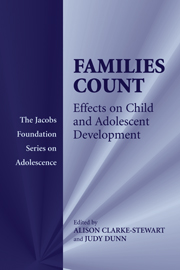Book contents
- Frontmatter
- Contents
- List of Contributors
- Introduction
- PART ONE RISK AND RESILIENCE
- PART TWO PEERS AND PARENTS
- PART THREE WORK AND FAMILY
- PART FOUR DISCORD AND DIVORCE
- PART FIVE NEW AND EXTENDED FAMILY FORMS
- 11 New Family Forms
- 12 Grandparents, Grandchildren, and Family Change in Contemporary Britain
- PART SIX CONCLUSIONS AND COMMENTARIES
- Index
- References
11 - New Family Forms
Published online by Cambridge University Press: 05 June 2012
- Frontmatter
- Contents
- List of Contributors
- Introduction
- PART ONE RISK AND RESILIENCE
- PART TWO PEERS AND PARENTS
- PART THREE WORK AND FAMILY
- PART FOUR DISCORD AND DIVORCE
- PART FIVE NEW AND EXTENDED FAMILY FORMS
- 11 New Family Forms
- 12 Grandparents, Grandchildren, and Family Change in Contemporary Britain
- PART SIX CONCLUSIONS AND COMMENTARIES
- Index
- References
Summary
In July 2004, Louise Brown, the first “test-tube” baby celebrated her 25th birthday. In the years since her birth, in vitro fertilization (IVF) has made the transition from the realm of science fiction to a commonly accepted treatment for infertility. The 1970s was also a time when another new and controversial family type, lesbian-mother families, came to the fore, and when families headed by single heterosexual mothers began to cast off the stigma associated with illegitimacy and divorce. Today, there exists a variety of new family forms made possible through advances in assisted reproduction technology. An example is the small but growing number of lesbian and single heterosexual women who are actively choosing assisted reproduction, particularly donor insemination, as a means of conceiving a child without the involvement of a male partner. In this chapter, I examine research on the psychological outcomes for parents and children in assisted reproduction families, with particular attention to the concerns and policy issues that have been raised by creating families in this way. The chapter is structured according to four major types of assisted reproduction: (1) Those involving “high-tech” procedures such as in vitro fertilization (IVF) and intracytoplasmic sperm injection (ICSI), (2) those involving gamete donation such as donor insemination (DI) and egg donation, (3) those resulting in nontraditional families such as single mother- and lesbian- mother families, and (4) those involving surrogate mothers. Although the four categories are not mutually exclusive, each raises a specific set of concerns regarding family functioning.
- Type
- Chapter
- Information
- Families CountEffects on Child and Adolescent Development, pp. 273 - 298Publisher: Cambridge University PressPrint publication year: 2006
References
- 5
- Cited by

